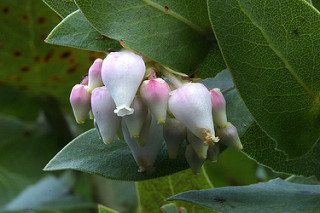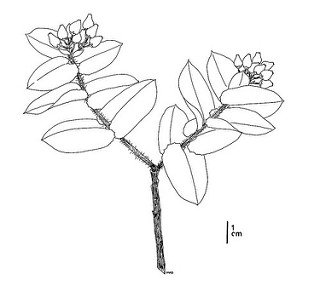(Arctostaphylos pallida)
 Arctostaphylos pallida. Photo © Steve Matson.
Arctostaphylos pallida. Photo © Steve Matson.
 Arctostaphylos pallida. CDFW illustration by Mary Ann Showers. (Click to enlarge)
Arctostaphylos pallida. CDFW illustration by Mary Ann Showers. (Click to enlarge)
Pallid manzanita (Arctostaphylos pallida) is a California endangered plant species, which means that killing or possessing this plant is prohibited by the California Endangered Species Act (CESA)(opens in new tab). This species is also listed as threatened under the federal Endangered Species ActEndangered Species Act(opens in new tab). Pallid manzanita is a member of the heath family (Ericaceae) and is a tall evergreen shrub that can grow up to 4 meters (13.1 feet). It has pale green leaves that surround the stem, and white to rose colored, urn-shaped flowers. Flowering generally occurs from December to March. Pallid manzanita grows in maritime chaparral communities, often in association with other woody species such as brittle leaf manzanita (Arctostaphylos crustacea ssp. crustacea), California huckleberry (Vaccinium ovatum), golden chinquapin (Chrysolepis chrysophylla var. minor) and several shrubby oak species (Quercus spp.). It also occurs in oak/bay (Quercus spp./Umbellularia californica) woodland in association with Monterey pine (Pinus radiata), blue gum (Eucalyptus globulus), pacific madrone (Arbutus menziesii), and other woody species. It requires frequent summertime fog and occurs on relatively cool, moist, and stable sites in close proximity to the San Francisco Bay. Naturally occurring pallid manzanita populations occur in two main geographic areas: Huckleberry Ridge in Alameda County and Sobrante Ridge in Contra Costa County. In addition, a small outplanted population occurs at Tilden Regional Park in Contra Costa County. At the time of this webpage posting, the California Natural Diversity DatabaseCalifornia Natural Diversity Database(opens in new tab) reports seven natural occurrences and one transplanted occurrence of this species, all of which are presumed to still exist.
One of the most significant threats to pallid manzanita is infection by a soil-borne pathogen, Phytophthora cinnamomi, which causes root and crown rot in many woody species resulting in plant mortality within months of showing signs of infection. Phytophthora cinnamomi has been confirmed to infect and kill pallid manzanita at populations located on Huckleberry Ridge, but has not yet been detected at the Sobrante Ridge populations. Human transport of contaminated soil is the primary vector for introducing this pathogen into new areas. Once it has been introduced into an area, its movement is facilitated by water flow, especially downhill. There is no known cure for infected plants, but treatment with phosphite may limit the spread of the disease.
Pallid manzanita is highly shade intolerant whereby shading from other shrubs and trees poses a significant threat to its existence. An altered fire regime is also a threat to the continued existence of pallid manzanita. Although the species requires fire for natural seed germination, too frequent a fire interval can deplete the soil seed bank before enough seeds have become deeply buried enough in the soil to withstand fire. Pallid manzanita commonly occurs in close proximity to human structures; the plants represent an extreme wildfire hazard and have been targeted for removal to reduce the threat of wildfire. Additionally, this species is threatened by the use of goat grazing by the City of Oakland to reduce wildfire fuel loads, and is vulnerable to inbreeding depression and stochastic events due to its small number of populations.
Recovery actions needed for this species include expanding existing stands of pallid manzanita and establishing additional stands. In addition, the U.S. Fish and Wildlife Draft Recovery Plan recommends implementing management plans that include and prioritize: 1) the control of Phytophthora cinnamomi at the stand level; 2) prevention of the spread of Phytophthora cinnamomi at the landscape level; 3) competing native and non-native vegetation management; 4) maintaining viable soil seed banks; 5) appropriately timed stand regeneration; 6) maintenance of genetic diversity; and 7) compatible fuel reduction methods and treatments.
CDFW may issue permits for pallid manzanita pursuant to CESA(opens in new tab), and you can learn more about the California laws protecting pallid manzanita and other California native plants. Populations of pallid manzanita occur in CDFW’s Bay Delta Region(opens in new tab). More information is also available from the U.S. Fish and Wildlife Service Species Profile for pallid manzanitaU.S. Fish and Wildlife Service Species Profile for pallid manzanita(opens in new tab).
Updated 12/8/2015